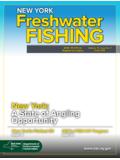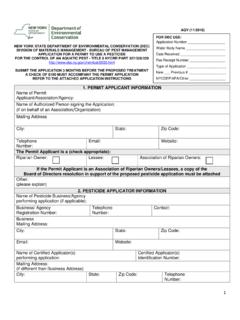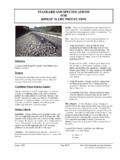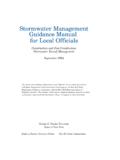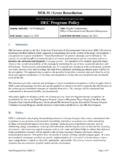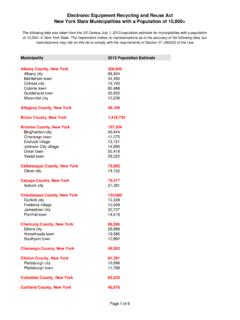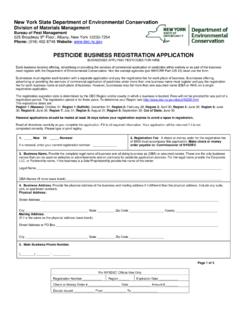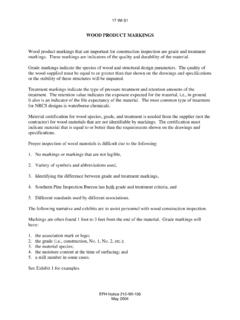Transcription of Snakes of New York - New York State Department of ...
1 Familiar shapes to most people, Snakes are legless vertebrates whose long bodies are cov- ered with scales. e scales can be smooth or contain a ridge which gives the snake a rough Venomous Snakes l Snakes . appearance. Snakes periodically shed their skin as they increase in size. ere are 17 spe- cies of Snakes found in New York State three are venomous, most are rarely seen. I. W hile New York is home to three of New York Snakes are carnivorous and swallow their species of venomous Snakes , most prey whole. Depending on the species, they people will probably never see them. will dine on everything from earthworms, Distinguishing a venomous snake slugs and insects to small birds, mammals, from a harmless one can be di cult. frogs, salamanders, sh and even other One characteristic many look for is the Snakes . While most of New York's snake spe- A Sampler of Our Most presence of a pit between the nostril and cies kill prey by seizing them with their jaws the eye, but if you don't know how to Commonly Seen Species and swallowing them whole, a few species, such as the black rat snake and milk snake, identify snake species and you're close may kill by wrapping their body around the enough to see the pit, you're too close.
2 Prey to constrict it. A second characteristic to look for is Snakes reproduce either by live birth or by the shape of a snake's head. Venomous laying eggs in hollow logs, sawdust piles or Snakes have broadly triangular heads;. mulch. e eggs incubate unattended. In the however, this characteristic can be winter, Snakes must retreat to a subterranean deceiving because many of the non- (underground) site where they are protected venomous species can atten and widen from freezing. Valued for their ability to kill rodent and their heads when provoked, giving their insect pests, Snakes are also very interesting heads a triangular appearance as well. creatures to watch. Most Snakes found around If you're in doubt, leave the snake alone. homes are seeking food, shelter or mates It will most likely move o in a di erent and will move on if they can't nd what they direction. are looking for. While most Snakes prefer ~. to retreat or hide quickly when approached by people, many will strike at larger prey or threatening humans.
3 Except for the venom- ous species, Snakes ' teeth are quite small and Text by Richard Bothner and Alvin Breisch hardly able to break a person's skin. However, Artwork by Jean Gawalt larger Snakes are capable of drawing blood Maps by John Ozard and as such, people should exercise caution (based on NY Amphibian & Reptile Atlas Project). around all Snakes , whether venomous or not. Design by Frank Herec. Being careful around Snakes not only protects yourself, but protects the Snakes as well. Reprinted from New York State Conservationist. To subscribe, call 1-800-678-6399. or visit Common Garter Snake e common garter snake is New York's most common snake species, frequently found in lawns, old elds and woodland edges. One Black Rat of three closely related and similar appearing snake species found in the State , the garter Snake snake is highly variable in color pattern, but e black rat snake is our longest snake, reaching six the blotches.
4 Is is a woodland species, but is found is generally dark greenish with three light feet in length. Its scales are uniformly black and faintly around barns where it is highly desirable for its abil- stripes one on each side and one mid- keeled, giving it a satiny appearance. In some individu- ity to seek and destroy mice and rats, which it kills by dorsal. e mid-dorsal stripe can be barely als, white shows between the black scales, making coiling around them and squeezing. Around farmyards, visible and sometimes the sides appear to the snake look blotchy. Sometimes confused with the its eggs are o en laid in shavings piles used for livestock have a checkerboard pattern of light and dark milk snake, the young black rat snake, which hatches bedding. squares. is species consumes many kinds of from eggs in late summer, is prominently patterned insects, slugs, worms and an occasional small with white, grey and black, but lacks both the Y or frog or mouse.
5 Length: 16 to 30 inches. V on the top of the head, and the reddish tinge to Timber Rattlesnake Copperhead e copperhead is an attractively-patterned, venomous snake with a pinkish-tan color super- imposed on darker brown to chestnut colored saddles that are narrow at the spine and wide at the sides. e top of the head is usually copper in color, hence its name. Although not as wide- spread, this species is found in habitat similar to that of the timber rattlesnake. e copperhead primarily eats small rodents, but will take any- thing from caterpillars to small birds. e young are born live and have a sulphurous- yellow tip on their tail that is used as a lure to entice prey. Length: two to three feet, rarely to 40 inches. e timber rattlesnake, a threatened species, is a eir preferred prey are small rodents up to the size stocky, venomous snake. It is quite variable in color, of chipmunks or squirrels. e heat-sensitive pits ranging from yellow with a series of V-shaped cross- between the eyes and nose help this snake catch prey bands, to almost solid black.
6 E tail ends in a broad, even at night. Young are born live in late summer and loose series of rattles that make a distinct buzzing follow the scent trail of their mother back to the den sound when shaken, warning all of their presence. to hibernate for the winter. Length: three to four feet, Only occasionally seen, this species is most frequently rarely to ve feet. encountered on rocky slopes within hardwood forests. Northern Water Milk Snake Hognose Snake Snake e hognose snake is a thick-bodied species with a strongly upturned snout. Color varies considerably from blotched browns and yel- lows to almost uniformly black. When startled it can widen its neck like a cobra and emit a loud hissing sound. is may be followed by rolling over on its back and playing dead.. e display is mostly blu , but gives the snake the common name of pu adder. e hognose feeds almost exclusively on toads and is most frequently found in sandy habitats. Length: 20 to 33 inches, rarely to 45 inches.
7 Milk Snakes are proportionately slender animals, with greyish-white bodies that have a series of reddish-brown blotches with black edges. e blotch on the top of the head surrounds a lighter- colored Y- or V-shaped mark. Locals o en mis- takenly refer to these Snakes as spotted adders. Milk Snakes are frequently found in and around barns, outbuildings and houses where they are at- e northern water snake is a moderately tracted to mice. is search for small rodents was heavy-bodied snake with irregular reddish misunderstood by early farmers who believed the brown bands across its lighter-colored back. Snakes sucked milk from their cows. Constrictors, e blotches along the spine alternate with these Snakes kill their prey by coiling around it smaller blotches along the sides. All are edged and squeezing. Length: two to three feet, rarely to with a darker brown or black. Older indi- four feet. viduals o en appear uniformly dark brown to almost black.
8 Is species is found in or near water and feeds primarily on frogs and small sh. Its proximity to water and o en defensive behavior cause many people to mistake it for a cottonmouth or water moccasin, a venomous species that has a northern limit of southern Virginia. Length: 18 to 48 inches.
